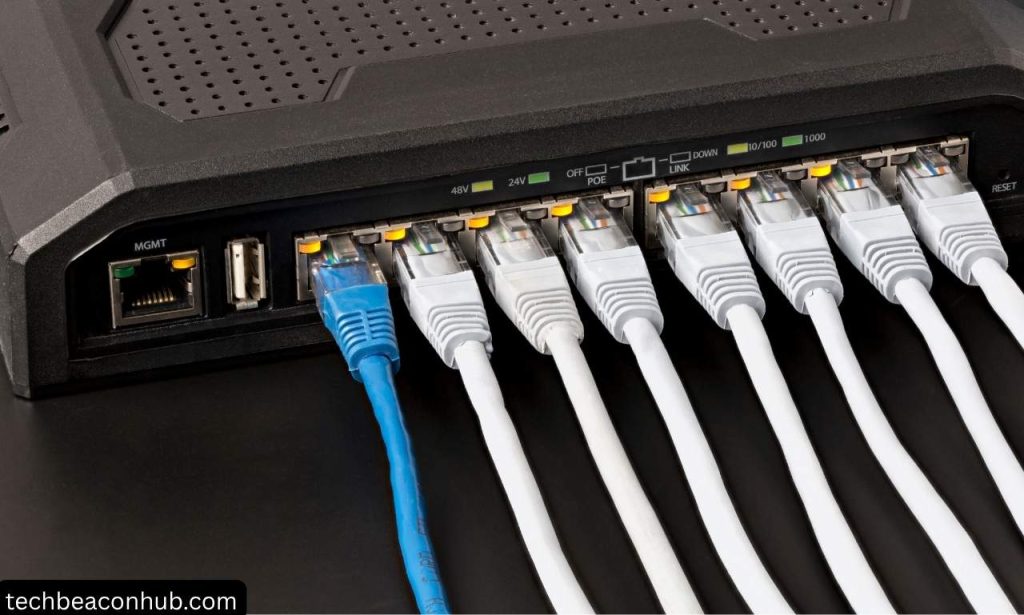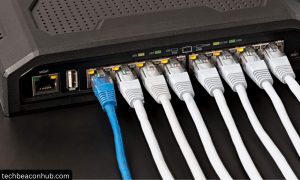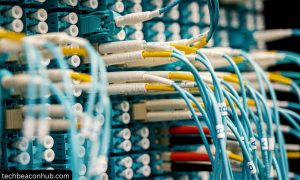Power over Ethernet, often called PoE, has changed how we connect and power network devices. Gone are the days when each device needed its own power outlet. I remember installing security cameras at my friend’s shop last summer. We saved hours by not having to wire separate power lines. PoE technology lets a single Ethernet cable carry both data and electricity. This setup reduces clutter, saves money, and simplifies installation. Network administrators love this practical solution for powering everything from phones to security cameras. The technology keeps evolving to meet growing power demands. Understanding PoE opens doors to smarter, cleaner network setups.
How does PoE work?

Power over Ethernet works through a clever system that combines electrical power with data transmission. The magic happens inside the cables we already use for networking. Standard Ethernet cables contain eight copper wires arranged as four twisted pairs. In traditional setups, only four wires carry network data. PoE takes advantage of those unused wires to deliver electrical current. The system requires a power source and a powered device to function correctly. You might not realize that PoE has been around since the early 2000s. The technology has matured significantly since then.
Power Sourcing Equipment (PSE)
The power journey begins with what we call Power Sourcing Equipment or PSE. This equipment serves as the electricity provider in the PoE setup. A PoE-enabled network switch commonly acts as the PSE in most installations. These special switches contain built-in electrical components that manage power distribution. Some networks use standalone devices called PoE injectors instead of switches. Injectors add power to existing network connections without replacing infrastructure. The PSE must carefully control voltage levels to protect connected devices. Most commercial PSE equipment supports multiple power modes to accommodate different devices.
Powered Devices (PD)
On the receiving end, we have Powered Devices that draw electricity from the Ethernet connection. These PDs contain special circuitry that works with incoming power signals. IP cameras represent one of the most common types of powered devices today. The PD must negotiate with the PSE to establish appropriate power levels. This negotiation process happens automatically when you connect a device. Different devices require varying amounts of electricity to function correctly. Modern PDs can request specific power classes based on their needs. This smart communication prevents damage from power mismatches.
Power Delivery Methods
PoE delivers power through two main methods known as Mode A and Mode B. In Mode A, electricity travels on the same pairs used for data transmission. This approach, sometimes called phantom power, cleverly combines signals. Mode B sends power over the spare pairs not used for data communication. Some advanced systems use all four pairs simultaneously for higher power delivery. The IEEE standards group establishes specific voltage ranges for safe operation. These standards ensure that different brands of equipment work together smoothly. The maximum cable length for reliable power delivery reaches about 100 meters. Beyond this distance, special extenders must boost the signal.
What devices use PoE?
A surprisingly wide range of devices can operate using Power over Ethernet technology. The list keeps growing as manufacturers embrace this convenient power method. IP phones were among the earliest adopters of PoE technology. These devices perfectly showcase the cable-reducing benefits of combined connections. Let me walk you through some typical applications you might encounter in various settings.
Network and Communication Devices
PoE powers critical network infrastructure in offices and homes worldwide. Wireless access points top the list of commonly powered networking equipment. These ceiling-mounted devices extend Wi-Fi coverage throughout buildings without nearby outlets. PoE works wonderfully for IP phones found on office desks everywhere. Network switches themselves can sometimes be powered through PoE from larger systems. Intercoms and emergency notification systems benefit from centralized power control. Video conferencing equipment increasingly supports PoE for more straightforward installation. Small network storage devices have joined the PoE compatibility lineup recently.
Security and Surveillance Equipment
The security industry has fully embraced PoE for powering essential monitoring systems. IP security cameras represent the most visible example in this category. These cameras operate continuously without requiring local power sources. Access control systems, including card readers, use PoE for both data and power. Security panels and alarm systems maintain operation during power outages with PoE. Video doorbells in commercial settings often utilize this technology. Motion sensors and environmental monitors work reliably with PoE connections. Facial recognition terminals and biometric scanners function perfectly with this power method.
Other PoE-Compatible Devices
Many specialized devices across various industries now support Power over Ethernet. Digital signage displays can receive content and power through a single connection. LED lighting systems in smart buildings use PoE for granular control. Point-of-sale terminals in retail environments simplify checkout counter wiring. Industrial sensors and controls benefit from centralized power management. Thin client computers with modest power needs work well with PoE. Audio speakers in commercial spaces can eliminate power brick clutter. Healthcare monitoring equipment gains reliability through PoE implementation. Smart building controls for HVAC systems operate effectively using this technology.
What are the benefits of PoE?
Power over Ethernet offers numerous advantages that explain its growing popularity. These benefits extend beyond simple convenience factors. Organizations increasingly recognize the strategic value of implementing PoE systems. Let’s explore the key advantages of this technology for your network.
Time and cost savings
Implementing PoE technology dramatically reduces both installation and ongoing maintenance expenses. The elimination of separate power cables cuts labor costs significantly. Electricians charge premium rates for running dedicated power lines to devices. Last year, I helped install a surveillance system that saved thousands in electrical work. Construction costs decrease when fewer holes need drilling for cable runs. The time required for deployment shrinks dramatically with simplified wiring needs. Troubleshooting becomes faster when dealing with single-cable connections to devices. Maintenance teams appreciate having fewer components that might potentially fail. Operating costs decrease through centralized power management and monitoring. The reduced complexity translates directly to budget savings for IT departments.
Flexibility
PoE systems offer exceptional adaptability that traditional power methods cannot match. Devices can be placed anywhere within Ethernet cable reach, regardless of outlet locations. Moving equipment becomes trivial when no separate power planning is needed. Adding new devices requires only running a single network cable. Temporary setups for events or testing happen quickly without electrical concerns. Remote locations with limited infrastructure benefit tremendously from this flexibility. The standardized nature of PoE works across various manufacturers and devices. Upgrading components rarely requires complete infrastructure overhauls. Different power classes allow the same system to support diverse device types. This adaptability supports changing business needs without significant reinvestment.
Safety
The safety advantages of Power over Ethernet often get overlooked despite their importance. PoE operates at lower voltages than standard wall power, reducing shock hazards. The technology includes built-in protections against power surges and electrical faults. Centralized power management allows immediate shutdown of specific ports if problems arise. Consolidated backup power systems protect all connected devices during outages. Fewer cables mean reduced fire risks from damaged wiring. The negotiation process prevents devices from receiving incorrect power levels. Water damage risks decrease with lower voltage requirements. Maintenance personnel face fewer electrical dangers when working with equipment. International safety standards govern PoE implementation across manufacturers. These protective features create peace of mind for network administrators.
Reliability
Network dependability improves significantly when implementing Power over Ethernet solutions. Centralized power management eliminates the variability of different power adapters. Backup systems can maintain critical functions during utility outages. The simplified infrastructure has fewer potential failure points to monitor. Power delivery standardization ensures consistent operation across devices. High-quality PoE equipment typically includes robust power conditioning features. Remote monitoring capabilities allow preemptive identification of potential issues. The automatic negotiation process prevents power-related device failures. Connected systems maintain synchronization due to unified power sources. Controlled startups after outages avoid surges of power to sensitive equipment. This reliability directly translates to improved uptime for essential systems.
Scalability
PoE infrastructure adapts beautifully to growing organizational needs over time. Adding new powered devices requires minimal planning or additional infrastructure. Power budgeting features in advanced switches allow precise capacity management. Organizations can start small and expand their PoE implementation gradually. The standardized approach works across generations of devices and technologies. Power requirements can scale from tiny sensors to larger displays. Campus-wide deployments become manageable through hierarchical PoE distribution. Different power classes accommodate varying device needs within the same system. Future-proofing happens naturally as standards evolv, withe backward compatibility. This scalability protects technology investments against rapid obsolescence concerns.
Conclusion
Power over Ethernet has transformed how we think about network deployment and device installation. The ability to deliver both data and electricity through a single cable simplifies countless scenarios. From security cameras to phone systems, PoE continues finding new applications. The technology provides compelling benefits across cost, flexibility, safety, reliability, and scalability dimensions. Network planners increasingly consider PoE compatibility essential rather than optional. As power delivery capabilities expand, more devices will join the PoE ecosystem. The standards continue evolving to meet growing power demands while maintaining compatibility. Consider exploring PoE options when planning your next network upgrade or device deployment. The initial investment typically pays dividends through reduced complexity and ongoing savings. This practical technology represents one of networking’s most valuable innovations.
Also Read: How can server-side tracking help your business?
FAQs
Standard PoE implementations work reliably up to 100 meters (328 feet) using normal Ethernet cabling.
PoE standards range from 15.4W in the original specification up to 90-100W in the latest standards.
No, standard Cat5e or better Ethernet cables work perfectly with PoE technology.
No, proper PoE equipment first checks if a device supports PoE before sending power.
Initially yes, but the total installation cost typically proves lower when considering reduced electrical work.



